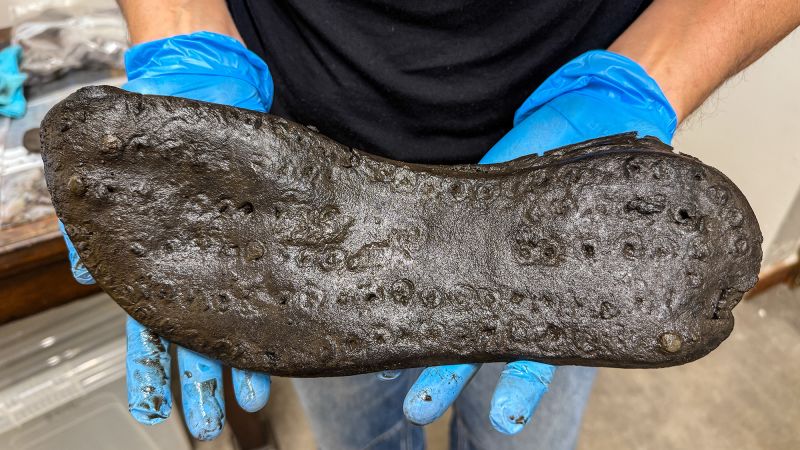Archaeologists Unearth Giant Shoes at Hadrian’s Wall Fort

Archaeologists have discovered a collection of unusually large shoes at the site of Magna Fort, a first-century military installation along Hadrian’s Wall in northern Britain. This significant find raises intriguing questions about the size and characteristics of the soldiers who once occupied this Roman stronghold. The shoes, excavated in May, were part of a larger haul of 34 items of footwear, which included work boots and smaller children’s shoes, providing a glimpse into the lives of the 4,000 individuals—men, women, and children—who inhabited the area just south of the Scottish border.
Among the discoveries, eight shoes measured over 11.8 inches (30 centimeters) in length, equivalent to a US men’s size 13.5 or greater, indicating that exceptionally tall individuals may have served at this northern frontier of the Roman Empire. In contrast, the average shoe found at a neighboring Roman fort typically measures around a US men’s size 8, according to a news release detailing the findings.
Unraveling the Mystery of the Giant Footwear
Rachel Frame, a senior archaeologist leading the excavation, expressed surprise at the size of the shoes. “When the first large shoe started to come out of the ground, we were looking for many explanations, like maybe it’s their winter shoes or people were stuffing them, wearing extra socks,” she recalled. “But as we found more of them and different styles, it does seem to be that these were just people with really large feet.” As the excavation continues, further investigations may reveal the identities of those who wore these giant shoes.
During its operational years, which began around AD 85, Magna Fort housed various Roman military units and their families, who rotated in and out of the site. Archaeologists believe that troops, such as Hamian archers from modern-day Syria, Dalmatian mountain soldiers from Croatia and Serbia, and Batavians from the Netherlands, took up residence, although the duration of their stay remains uncertain. Troops frequently abandoned personal items, including shoes, in the surrounding trenches as they departed for distant postings.
Dr. Elizabeth Greene, an associate professor of classics at the University of Western Ontario, emphasized the importance of these discarded items. “As archaeologists, we like trash,” she said. “You get those habitational layers where things were just left behind, maybe forgotten about, and that tells us more about the space.” Greene has studied thousands of shoes from the nearby Vindolanda Roman Fort, one of the most thoroughly researched Roman forts along Hadrian’s Wall. She noted that the Magna shoes share characteristics with those found at Vindolanda, including thick cowhide leather soles secured with iron hobnails.
Implications and Challenges of the Discovery
The durable construction of the Magna shoes suggests they may have survived due to ancient tanning methods that employed crushed vegetation to create a protective coating. While only a few of the shoes recovered from Magna still possess their upper parts, various styles have been identified, including military boots and sandals.
Greene highlighted that the exceptionally large size of the Magna shoes could mean their owners were notably taller than the average Roman soldier, who, according to ancient military manuals, typically stood around 5 feet 8 inches or 5 feet 9 inches tall. Notably, only 16 out of the 3,704 shoes documented at Vindolanda measured over 11.8 inches. The diversity of soldiers stationed around Hadrian’s Wall, coming from different parts of the vast Roman Empire, likely contributed to a range of physical characteristics.
To further investigate the identities of the shoe owners, Frame and her team plan to examine the footwear for wear patterns. Any foot impressions left could help them model the feet of the original users. Unfortunately, linking these shoes to human remains poses a challenge, as Roman practices near Hadrian’s Wall often involved cremation, leaving few bones behind. So far, any bones discovered at the Magna site have been too fragile to yield useful information.
As the excavation progresses, the team continues to unearth pottery and other artifacts that could assist in dating the site and correlating it with the known occupants. However, Frame expressed concern over the urgency of their work due to changing climate conditions that threaten the preservation of these ancient materials.
“The more our climate changes, the more we get heat waves and droughts or months’ worth of rain in one weekend,” Frame noted. Such fluctuations have altered soil conditions and increased oxygen levels, which accelerate decay. “These personal objects really put the real human people back into the picture,” she added, emphasizing the importance of understanding the everyday lives of those who lived and worked at the fort.






